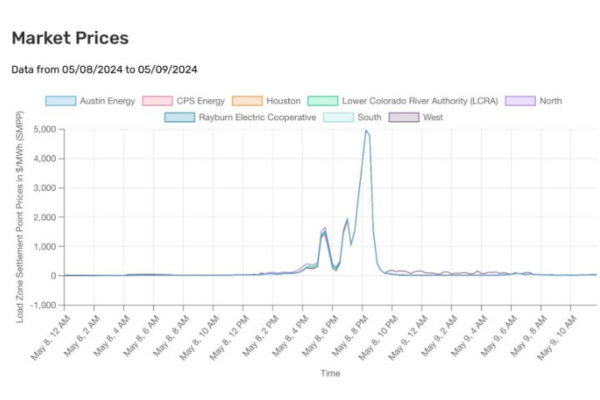- Who We Serve
- What We Do
- About Us
- Insights & Research
- Who We Serve
- What We Do
- About Us
- Insights & Research
Texas Electricity Surge
In early May, electricity prices spiked to $5,000 per megawatt-hour (MWh) in Texas. Most readers will be more familiar with kilowatt-hours (kWh), which is used in residential electric bills. $5,000 per MWh computes nicely through the magic of the metric system to $5 per kWh. To put this price rise into perspective, an average home in Texas consumes somewhere around 1,000 kWh per month. Thus if this price surge continued, a homeowner in Texas could expect a $5,000 monthly electric bill.
Luckily the surge in price was just that…a surge lasting no more than about 4 hours in total. But the incident highlights one of the challenges in our energy transition to cleaner and renewable energy sources. Renewable energy sources have lower capacity factors and are less reliable than conventional energy supply coming from hydrocarbon and nuclear power plants.
While I have found no official explanation, the timing of the price surge (late in day as sun sets) suggests that solar power generation was falling. As it was a warm day, electricity usage was likely still high especially as residential users returned home in the evening. And conventional sources of power (e.g. hydrocarbons) were unable to pick up the slack, probably because spring is an optimal time to catch up on coal and gas power plant maintenance before the summer heat arrives. Thus demand overwhelmed supply in an extreme but momentary manner.
Texas has done a remarkable job pivoting to renewable resources. The state is admirably leading the way in solar and wind power generation. However this situation reflects on the importance on energy redundancy as we pivot to renewable energy.
Even without this spike, electricity prices in Texas have risen from an average of 9 cents per kWh in August 2023 to over 17 cents per kWh in May. Reuters recently quoted the CEO of energy analytic firm Amperon Sean Kelly as saying: "With the growth of renewables, the retirement of base load fossil-fired generation and the dependence on renewables, on days renewables are not showing up, it's going to be very pricey."
Examples such as May’s spike and higher average electricity prices since August in Texas, an area with abundant energy resources, have led many investors to anticipate continued opportunities in the energy sector.
The below graph depicts the price spike. Normally this graph would show price levels between $5 and $200 per MWh, which are barely perceptible on this graph’s scale.

Meet Your Expert
Grant Johnsey
Grant is responsible for delivering capital market solutions to institutional clients across agency brokerage, transition management, security finance, and foreign exchange.

Northern Trust Securities, Inc.(NTSI), Member FINRA, SIPC and a subsidiary of Northern Trust Corporation. Products and services offered through NTSI are not FDIC insured, not guaranteed by any bank, and are subject to investment risk including loss of principal amount invested. Additional disclosures are included in the link, see http://www.northerntrust.com/ntsidisclosure
Business Continuity Notice- Northern Trust Securities, Inc.